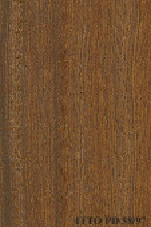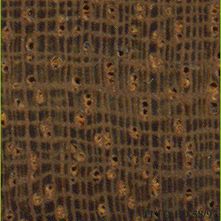
KOSIPO (Entandrophragma candollei)
Trade Name
Kosipo
Scientific Name
Entandrophragma candollei Harms
Family
MELIACEAE
Common Names
Kosipo (Côte d`Ivoire); Kosipo-mahogany (Germany); Unscented mahogany; Tshimaye rouge; Tshimaie tshikunze; Sapele-heavy; Pepedom; Penkwa; Okpoloco; Lifaki mpembe; Heavy sapele; Heavy mahogany; Esaka; Diamuni; Bouboussou rouge; Atom assie; Atom; Omu (United Kingdom); Kosipo-mahogani (Germany); Lifuco (Angola); Impompo (Zaire); Atom-assie (Cameroon); Heavy sapelle (Nigeria); Omu (Nigeria); Penkwa-akowaa (Ghana); Candollei (Ghana); Kosipo
Scientific Name Synonyms
Entandrophragma ferrugineum A. Chev.; Entandrophragma choriandrum Harms in Mildbr.
Description Of The Tree
Botanical Description
It is a large tree, sometimes of more than 50 m tall. The bole is cylindrical, straight and clear to 32 m in length. The trunk diameter is up to 230 cm, buttressed to a height of about 3 m. It is known or inferred that the harvesting of specimens from th
Natural Habitat
Entandrophragma candollei is found in evergreen, moist and transitional forests.
Natural Distribution
In West Africa, from Angola to the Democratic Republic of the Congo.
Wood Identification
Anatomic Description Of Wood
Wood diffuse porous. Occasionally vessels exclusively solitary (over 90%). Tangential diameter of vessel lumina 200 micras or more (large). Brown-colored deposits in heartwood vessels. Non-vestured pits. Vessels per mm2 less than 6 (rare). Simple perforation pl Occasionally axial parenchyma in marginal or in seemingly marginal bands. Occasionally axial parenchyma confluent. Axial parenchyma in continuous tangential lines or fine bands. Siliceous bodies in the axial parenchyma cells. 5 to 8 cells per parenchyma stran 4 to 10 rays per mm (medium). Rays non-storied. Larger rays more than 4 seriate. Silica bodies in the ray cells. Body ray cells procumbent with one row of upright and/or square marginal cells (Kribs-III). Septate fibers present. Fibers with simple to minutely bordered pits.
-
 Wood Macro Photo Radial Plane
Wood Macro Photo Radial Plane
-
 Wood Micro Photo Of Transversal Section
Wood Micro Photo Of Transversal Section
Availability
Cites Status
Unrestricted
General Wood Description
Color
The sapwood is whitish to pale brown, it has a thickness of 5 to 7.5 cm. The heartwood is brown to dark purple brown, it is clearly demarcated. The silver figure is fine.
COLOR INDEX (1=Black, 7=Light yellow,white)
2
Grain
Straight or slightly interlocked, sometimes with an influence on further processing operations.
Texture
Texture is usually fine to medium.
Luster
The wood surface is described as low in luster.
Natural Durability
Because of its variable resistance it is considered as moderately durable to decay. Without treatment, it can be used when risks of occasional re-humidification; it is not suited for uses with risks of permanent or long-lasting humidification. Moderately
Natural durability index (1= Very high durability, 7=Vey low durability)
4
Internal Growth Stresses
No growth stresses are reported in this species.
Silica Content
Silica Content: Presence of silica is reported in timber of this species. Amounts over 0.05% may affect the wood processing. Silica Value: 0.21
Resistance To Impregnation
Difficult to treat with only a low penetration of the preservative products.
Wood Physical Properties
Basic Density or Specific Gravity (O.D. weight/vol. green) (g/cm³)
0.62
Air-dry Density (Weight and volume at 12%MC) (g/cm³)
0.69
Total shrinkage Tangential (Saturated to 0%MC) (%)
6.7
Total shrinkage Radial (Saturated to 0%MC) (%)
4.8
Recommended Dry Kiln Schedule
FR-10
Dimensional stability ratio (Total Tangential Shrinkage %/Total Radial Shrinkage %)
1.4
Wood Chemical Properties
Wood Mechanical Properties
Bending Strength (MOR),12%MC (kgf/cm²)
890
Stiffness (MOE) 12%MC (kgf/cm²)
114077
Compression parallel to fiber 12%MC (kgf/cm²)
542
Compression perpendicular to fiber 12%MC (kgf/cm²)
69
Shear strength radial 12%MC (kgf/cm²)
70
Janka hardness (side) 12%MC (kgf)
591
Janka hardness (end grain) 12%MC (kgf)
688
Workability
Sawing
It is easy to saw.
Rotary Veneer Cutting
Suitable for slicing, also suitable for peeling if treated.
Sliced Veneer
Suitable for slicing, also suitable for peeling if treated.
Blunting Effect
Severe blunting effect; stellited blades for sawing and carbide tools for machining are recommended.
Machining
Possible difficulties caused by interlocked grain are reported.
Planing
Moderately easy; tools must be cautiously sharpened.
Moulding
Easy; no particular problems.
Turning
30
Boring
Easy; no particular problems.
Mortising
Easy; no particular problems.
Nailing
Pre-boring is necessary.
Gluing
Glues well if basic gluing technical rules are followed.
Sanding
Easy to perform; it gives good results.
Polishing
Can be polished without surface preparation.
Response To Hand Tools
No particular problems.
REFERENCED USES
End Uses Summary
HOUSING GENERAL, beams, joists, boards, flooring, parquet, frames, steps, panelling, fittings, FURNITURE AND CABINETS, luxury furniture, cabinets, PLYWOOD AND VENEER, faces, Decorative veneer, TURNING, ornaments, turned furniture, OTHER AND MUSICAL INSTRUMENTS, shingle
General Housing
- 10 - Silica in Timbers
Beams
- 11 - Prospect: The wood database
Joists
- 12 - Tropical timbers of the world. Part I-Tropical American Species
Boards
- 13 - Dry kiln schedules for commercial woods. Temperate and tropical. Section III. Latin American (Mexico, Central, and South America) Woods–Conventional Temperatures
Flooring
- 14 - Handbook of Hardwoods
Parquet
- 15 - Empire Timbers
Frames
- 16 - Woods of the World
Steps
- 17 - Tree Conservation Database
Paneling
- 18 - W3TROPICOS Missouri Botanical Garden
Fittings
- 19 - Silica in Timbers
Furniture Cabinets
- 21 - Tropical timbers of the world. Part III-Southeast Asian and Oceanian Species.
Furniture, Luxury
- 22 - Dry kiln schedules for commercial woods. Temperate and tropical. Section IV-Asian and Oceanian Woods
Cabinet
- 24 - Empire Timbers
Panels, Veneers
- 25 - Directory of Timber Trade Malaysia
Faces
- 26 - Annual Review and Assessment of the World Timber Situation 1998-ITTO
Decorative veneer
- 28 - Ministry of Agriculture, Fisheries & Forest of Fiji
Turning
- 30 - Embassy of Honduras in Japan
Ornaments
- 31 - Embassy of Colombia in Japan
Turned Articles
- 32 - Embassy of Cote d`Ivoire in Japan
Shingles
- 77 - Amazonian Timbers, Characteristics and Utilization Volume I; Tapajós National Forest
Please Provide Information To View Producer Information